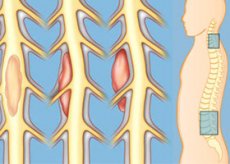Medical expert of the article
New publications
Spinal cord tumors and back pain
Last reviewed: 08.07.2025

All iLive content is medically reviewed or fact checked to ensure as much factual accuracy as possible.
We have strict sourcing guidelines and only link to reputable media sites, academic research institutions and, whenever possible, medically peer reviewed studies. Note that the numbers in parentheses ([1], [2], etc.) are clickable links to these studies.
If you feel that any of our content is inaccurate, out-of-date, or otherwise questionable, please select it and press Ctrl + Enter.

Spinal cord tumors may develop within the spinal cord parenchyma (intramedullary), directly damaging tissue, or outside the spinal cord (extramedullary), causing compression of the spinal cord and nerve roots. Symptoms include progressive back pain and neurologic deficits corresponding to the affected area of the spinal cord or nerve roots. Diagnosis is by MRI. Treatment may include corticosteroids, surgical removal, and radiation therapy.
Spinal cord tumors may be intramedullary (within the spinal cord parenchyma) or extramedullary (outside the parenchyma). The most common intramedullary tumors are gliomas (eg, ependymomas, poorly differentiated astrocytomas). Extramedullary tumors may be intradural or extradural. Most intradural tumors are benign, typically meningiomas and neurofibromas, which are most often primary. Most extradural tumors are metastatic, usually from carcinoma of the lung, breast, prostate, kidney, thyroid gland, or lymphoma (eg, Hodgkin lymphoma, lymphosarcoma, reticular cell sarcoma).
Intramedullary tumors infiltrate and destroy the spinal cord parenchyma and may extend over multiple spinal segments; intramedullary tumors may result in syringomyelic cavities. Intradural and extradural tumors cause neural injury by compressing the spinal cord or nerve roots. Many extradural tumors cause bone destruction before compressing the spinal cord.
Symptoms of spinal cord tumors
Symptoms and diagnosis
- Constant back pain that does not improve with changes in body position
- Night pain; weight loss
- Blood protein electrophoresis (myeloma)
- PSA>10ng/ml
- MPT; CT; X-ray are informative 65%
- Isotope scintigraphy is informative in osteoblastic tumors
The early symptom is pain. It progressively increases, is independent of activity, and is aggravated by lying down. The pain may be localized to the back, radiate along the dermatome (radicular pain), or have both of these characteristics. Neurological deficits develop later. The most typical are spastic paresis, urinary and fecal incontinence, and dysfunction of some or all sensory tracts, particularly at the level of the affected spinal cord segments and below. The deficit is usually bilateral.
Most patients with extramedullary tumors complain of pain, but some may present with sensory disturbances in the distal lower extremities or segmental neurologic deficits and spinal cord compression as the first clinical symptoms. Symptoms of spinal cord compression tend to worsen rapidly because most extradural tumors are metastatic. Symptoms of nerve root compression are also common and include pain and paresthesias followed by decreased sensation, muscle weakness, and, with prolonged compression, exhaustion that corresponds to the duration of the pain syndrome.
Favorable
- Osteoid osteoma
- Osteoblastoma
Malignant
- Myeloma
- Osteosarcoma
- Chondrosarcoma
- Metastases to the skeleton
Malignant
- 75% of all cases are in patients over 50 years of age
- In 30% of cases, there is a history of oncological pathology
- Less than 1% of all back pain cases
Reasons
- 2/3 metastases
- The most common primary tumor is myeloma
- Extravertebral tumors: pancreas, kidneys, retroperitoneal lymphomatosis
- Metastatic tumors
The most common causes in descending order are:
- Lungs
- Breast
- Prostate
- Kidneys
- Origin unknown
- Sarcoma
- Lymphoma
- Colon
- Thyroid gland
- Melanoma
Localization of metastases
- Cervical spine 6 - 19%
- Thoracic region - 49%
- Lumbar region - 46%
Diagnosis and treatment of spinal cord tumors
Spinal tumor is suspected in the presence of progressive, intractable, or nocturnal pain or radicular pain, segmental neurological deficit, or neurological deficit of unknown genesis, indicating spinal cord or nerve root involvement. Suspicion also arises in case of unspecified back pain in patients with lung, breast, prostate, kidney, thyroid tumors, or lymphoma. Diagnosis involves MRI of the affected area of the spinal cord. CT is an alternative method, but less informative. Patients with segmental neurological deficit or suspected spinal cord compression require urgent diagnosis and treatment.
If MRI does not reveal a spinal tumor, other space-occupying processes (eg, abscess, arteriovenous malformation) and paravertebral tumors should be considered. Spinal radiography performed for other indications may show bone destruction or paraspinal tissue involvement in metastatic tumors.
For patients with neurologic deficit, corticosteroids (eg, dexamethasone 50 mg intravenously, then 10 mg orally 4 times daily) should be given promptly to reduce spinal cord swelling and preserve function. Tumors compressing the spinal cord should be treated as quickly as possible. Some tumors in favorable locations can be surgically removed.
The deficit resolves in about 1/2 of these patients. Tumors that cannot be removed surgically are treated with radiation therapy, with or without surgical decompression. Metastatic extradural tumors that compress the spinal cord are usually removed surgically, followed by radiation therapy. Extradural metastases that do not compress the spinal cord can be treated with radiation therapy alone, but may require removal if radiation therapy is ineffective.


 [
[